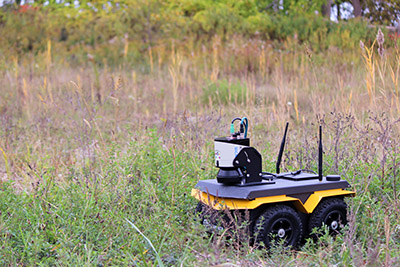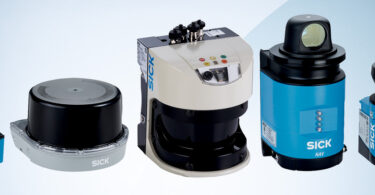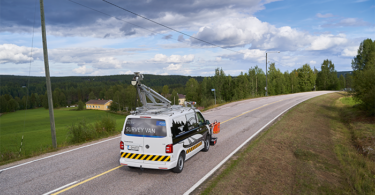 Designing a robot for outdoor use—for example, in agricultural or mining robots—comes with a unique set of considerations when selecting navigational hardware. For example, outdoor robots must contend with inclement weather, blinding sunlight, and variable temperatures that can interfere with scanner function and impair reliability. Outdoor LiDAR is a great way to help these robots handle the elements.
Designing a robot for outdoor use—for example, in agricultural or mining robots—comes with a unique set of considerations when selecting navigational hardware. For example, outdoor robots must contend with inclement weather, blinding sunlight, and variable temperatures that can interfere with scanner function and impair reliability. Outdoor LiDAR is a great way to help these robots handle the elements.
But choosing the right laser scanner (LiDAR) ensures accurate navigation and extends the life of the robot’s navigation system even in adverse conditions.
Below are five important considerations for choosing a laser scanner when designing a robot for outdoor use.
1. Resistance to Ambient Light
One key challenge facing outdoor robots is ambient light. LiDAR uses time-of-flight technology, which means the scanner emits a pulse of light that is then reflected by a target, if present. The time required for the pulse to travel between the scanner and the reflector and back again is proportional to the distance. This allows the robot to detect and avoid obstacles in its path.
Intense sunlight can interrupt this process by preventing the scanner from being able to read its own returning light pulses. This could cause the laser scanner to malfunction, resulting in loss of navigation. So, for outdoor robots, always choose LiDAR with high sunlight resistance. For example, SICK offers the outdoorScan3, an extremely reliable scanner which is sunlight resistant up to 40,000 lx.
2. Resistance to Environmental Noise
In outdoor applications, environmental factors such as precipitation can interfere with a laser scanner’s ability to accurately detect obstacles (i.e., leading the robot to detect obstacles that are not there). Therefore, it is important to choose a laser scanner that is capable of maintaining a high level of accuracy even in adverse conditions—such as rain, snow, dust, etc. SICK’s laser scanners mitigate possible interference using multi-echo technology, ensuring reliability regardless of weather conditions and minimizing false alarms, saving time and money.
Multi-echo technology is important because part of the energy from a pulse of the laser scanner may be reflected by nearby objects like rain, while the remainder of the beam continues to propagate and is reflected by the actual obstacle. LiDAR with multi-echo technology evaluate these multiple “echoes” and ignore the closer, weaker reflections caused by the environmental factors. This cancels out the noise and helps prevent navigational issues.
3. High Environmental Rating
Related to the point above, it is also necessary to note the importance of a high environmental rating when choosing LiDAR for outdoor robots. Outdoor robots are exposed to the elements, and a laser scanner that is not resilient enough may experience early lifetime failure or may malfunction if doused with water. In contrast, a laser scanner with a rugged construction and high enclosure rating will help reduce mean time between failures (MTBF) and ensure the longevity of the navigational system.
For example, an IP 67 rating will ensure the reliability of the laser scanner even if it is immersed in water. All current SICK LiDAR are either IP 65- (water jet) or IP 67-approved, which makes them ideal for outdoor use.
4. Temperature Range
Another consideration that affects the function of the laser scanner is temperature range. Extremely cold or hot temperatures could damage a sensor (for example, causing the scanner housing to crack). Because of this, look for laser scanners that have a wide operating temperature range and a built-in temperature control system.
The TiM laser scanners from SICK, for example, are self-heating, while LMS scanners are equipped with internal heaters to moderate the temperature of the scanner, maintaining scanner function even in subzero weather.
5. Electromagnetic (EMI) Considerations
Finally, designers should be aware that an outdoor robot can find itself in a wide variety of environments which could contain varying strengths and types of electrical noise. This noise can induce itself onto the sensors and circuits of the control system which could cause the robot to behave erratically.
Although this factor is often overlooked in the early stages of the design process, electromagnetic noise can become problematic once robots are deployed into real-world environments—especially for robots operating near substations or powerlines. Coming from an industrial background where large motors and variable frequency drives (VFDs) are everywhere, SICK has developed LiDAR capable of dealing with this type of interference. SICK LiDAR have been approved for use in most EMC environments and meet EN61000 standards of compatibility.
Our Solution: The outdoorScan3
The outdoorScan3 addresses all of these challenges and more in a simple design. Thanks to intelligent algorithms and the outdoor safeHDDM® scanning technology, reliable operation is guaranteed even in harsh weather conditions, which considerably increases your productivity. Some features of the outdoorScan3 include:
- Filters through rain and snow
- Sunbeams have no effect (up to 40,000 lx)
- Reliable fog detection allows for safe stops
- Safeguarding and navigation in just one device
Interested in learning more about the capabilities of the outdoorScan3? We have compiled all information for this solution on our product page. If you want a safe and efficient machine for any outdoor use, the outdoorScan3 is a great first choice.
Originally published on LiDAR News.
[custom_author=Aaron Rothmeyer]




